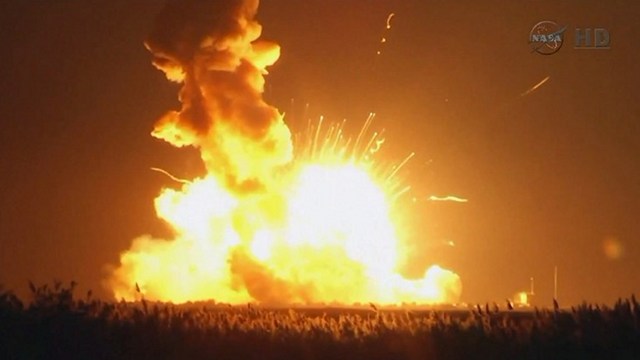SUMMARY
This is AI generated summarization, which may have errors. For context, always refer to the full article.

WASHINGTON DC, United States (2nd UPDATE) – An unmanned rocket owned by Orbital Sciences Corporation exploded Tuesday, October 28 (Wednesday, October 29 in Manila), in a giant fireball and plummeted back to Earth just seconds after launch on what was to be a resupply mission to the International Space Station.
“The Antares rocket suffered an accident shortly after lift-off,” NASA mission control in Houston said, describing the event as a “catastrophic anomaly.”
After the countdown, the base of the tall, white rocket ignited on cue, then rose a short distance into the air before it suddenly exploded in a fiery blast six seconds later.
Enveloped in flames, the rocket collapsed to the ground, as a cloud of dark gray smoke rose from the wreckage.
Investigators swiftly secured the perimeter of the area and forbade any outside interviews of witnesses or staff, citing classified equipment that had been aboard the spacecraft.
As night fell, fires were seen burning at the coastal launch pad at Wallops Island, Virginia where waves lapped at the shore.
It was unclear what caused the explosion, which occurred at 6:22 pm local time (2222 GMT).
“At this point it appears that the damage is limited to the facility,” a commentator on NASA television said.
All personnel in the area were accounted for, and there were no injuries, the US space agency said.
There was, however significant property damage.
The accident occurred just after Orbital’s unmanned Cygnus cargo ship blasted off toward ISS carrying 5,000 pounds (2,200 kilograms) of supplies for the 6 astronauts living at the research outpost.
It was the first nighttime launch of an Antares rocket, Orbital said.
Engineers said the countdown had gone smoothly, and there were no issues apparent with the machinery.
The mission, known as CRS-3, was to be Orbital’s fourth trip to the ISS, including an initial demonstration.
On NASA television, a man identified as Orbital executive vice president Frank Culbertson told his team to be as professional in this process as they are in a countdown, and urged them not to talk to the press.
“When we understand what happened, hopefully soon, then we will get things back on track,” Culbertson could be heard saying to staff on the radio.
“We have all seen this happen in our business before, and we have all seen our teams recover from this,” he said.
“Like I said, be very judicious about talking about it even amongst yourselves, in terms of speculation. Definitely do not talk outside our family.”
Orbital has a $1.9 billion contract with NASA for a total of eight supply missions.
The Cygnus craft, which is shaped like a massive beer keg, was to have remained berthed at the ISS for about five weeks.
After the US space shuttle program ended in 2011, leaving no government program to send humans to the space station, private companies raced to restore US access.
SpaceX’s Dragon was the first commercial spacecraft to make a supply journey there in 2010. – Rappler.com
Add a comment
How does this make you feel?





There are no comments yet. Add your comment to start the conversation.